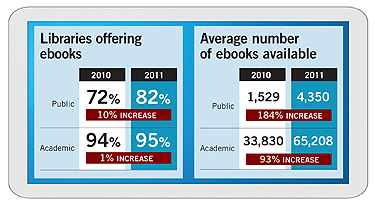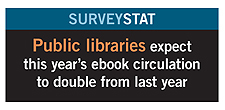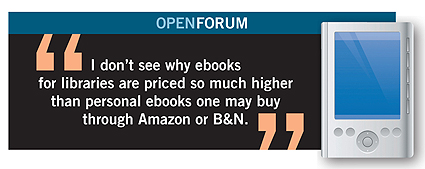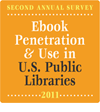LJ‘s second Ebook Survey proves libraries are adapting fast as patrons adopt and demand more in this new format
 We knew ebooks were booming in libraries, but now the 2011 Ebook Penetration & Use in U.S. Libraries Survey, just released by Library Journal and School Library Journal, confirms just how big the boom is. The answer: BIG, but with lots more uptake to go and some telling holdouts as the market and models take shape.
We knew ebooks were booming in libraries, but now the 2011 Ebook Penetration & Use in U.S. Libraries Survey, just released by Library Journal and School Library Journal, confirms just how big the boom is. The answer: BIG, but with lots more uptake to go and some telling holdouts as the market and models take shape.
The story is the most dramatic in public libraries: 66% of public libraries reported a steep increase in ebook requests, and 82% now offer them. They expect ebook circulation to double this year. That doubling is made possible by more robust collections: public libraries increased their offerings by 185%. In turn, they also have dedicated more of their budgets to ebooks, and expect ebooks to account for about 8% of their materials budget in five years. Five years, however, is a long horizon, and this number could be radically effected by the arrival of Kindle lending and if Hachette, Macmillan, and Simon & Schuster join the other big six publishers in library lending.
Academic libraries are almost all on board, with 95% offering ebooks; their ebook collections increased by 93%. They expect more growth in circ, and to see 19.1% of their budgets go to ebooks in five years. That could be even greater, as student expectations are influenced by ebook adoption beyond campus walls, and as faculty embrace the format.
 Answers beg new questions
Answers beg new questions
The survey also digs into just how libraries are serving up ebooks—for instance, 15% of public libraries and 12% of academics currently circulate preloaded devices, and 26% and 22%, respectively, expect to in the future. For those who might think ebooks are all about Romance, general adult nonfiction is popular in public libraries, rivaling best-selling fiction among the titles offered.
A glance at how libraries buy is also striking: 62% of public libraries and 58% of academics now buy ebooks via a consortium, and 37% and 76% also buy ebooks independently. This balance could be radically altered by the development of standard models (you guessed it: librarians most want maximum/simultaneous access or unlimited circs if one reader/one book) and by the rise of purchase on demand (better known in library circles as patron-driven acquisition).
 All these numbers, however, also point to the many libraries that have yet to embrace ebooks. For those not offering ebooks, the reasons range from capacity issues (simply not any money to get into the ebook game, or lack of tech support) to strategic caution about when to start spending dollars on ebooks (waiting to see what the best platform will be), and more. All real reasons that, when and if resolved, will bring even more libraries into the ebook market.
All these numbers, however, also point to the many libraries that have yet to embrace ebooks. For those not offering ebooks, the reasons range from capacity issues (simply not any money to get into the ebook game, or lack of tech support) to strategic caution about when to start spending dollars on ebooks (waiting to see what the best platform will be), and more. All real reasons that, when and if resolved, will bring even more libraries into the ebook market.
What this transition will mean for libraries has yet to be seen, but our ebook survey points to some good signs. For instance, 76% of public libraries believe that ebooks have drawn new people to the library. And, despite the ebook hype, and fear about the demise of libraries, the library experience is enriched by ebooks as another popular addition to collections already rich with various formats that keep users coming back.
View a slideshow of infographics from the survey:
Dig deeper into the ebook revolution
 Full versions of this report are available for purchase, focused on public, academic, or school libraries and complete with detailed data broken down by size of library and budget, comparison of 2011 and 2010 data, and hundreds of comments from librarians about their experiences with ebooks:
Full versions of this report are available for purchase, focused on public, academic, or school libraries and complete with detailed data broken down by size of library and budget, comparison of 2011 and 2010 data, and hundreds of comments from librarians about their experiences with ebooks:
2011 Survey of EBook Penetration and Use
(Separate reports for Public, K-12, and Academic Libraries)



As a Trustee of my local library who has been pushing ebook acquisitions, I am gratified by this article and the numbers.